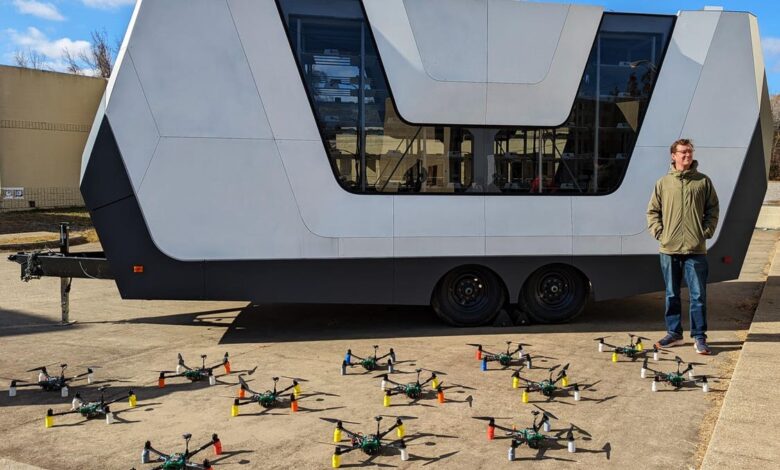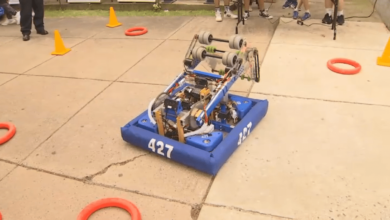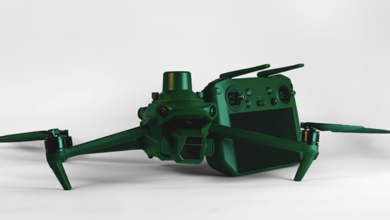Hives For U.S. Drone Swarms Ready To Deploy This Year

The HiveXL can store, launch, recover, recharge and relaunch up to 80 drones at the touch of a … [+]
Two U.S. companies are teaming up to supply technology for the military to operate mixed swarms of small drones with minimal human involvement. They are integrating battlefield drones with a system known as a Hive which can launch, recover and recharge drones automatically at the push of a button. This will make drone swarms a practical proposition on the battlefield and the technology will be ready to deploy this year.
Hive Brain
The Hive can handle a variety of drone types including the Teal 2 used by the U.S. Army
The partnership sees Red Cat Holdings joining forces with Sentien Robotics. Red Cat subsidiary Teal Drones builds the Teal 2 quadcopter, which is used by the U.S. Army and has been supplied to Ukraine. The Teal 2 has a flight time of 30 minutes, encrypted, jam-resistant communications, a control range of three miles and best-in-class thermal imager. Such drones are normally launched and recovered by hand, one at a time, but Hive changes that.
Red Cat’s partners are Sentien Robotics, who are working to decouple the drone launch and recovery process from human labor and dramatically scale up the number of drones that can be employed. Their Hive features robotic automation hardware and intelligence software to drone fleet enable operation. They currently offer two versions, the Hive Expedition mounted on the back of a vehicle, and the larger, towed Hive XL.
The Hive Expedition, showing the drone launch/recovery pad
The Hive Expedition weighs 400 pounds and can operate twelve or more drones depending on their size. The Hive XL is a 13,000-pound trailer which can house and deploy up to 80 drones. It is ‘platform agnostic’ meaning it can work with different drone types including Teal, Skydio, Parrot and DJI – this last is not used by the U.S. military due to its Chinese origins. The Teal 2 is designed to meet the U.S. government’s Blue SUAS standards.
Both types of Hive have autonomous control systems to launch and fly drones back and land them precisely on a launch pad with the help of an upward-facing stereoscopic camera system. A relief drone is automatically launched as soon as the first starts to run low on battery, and this will already be at work when the original is back inside the Hive’s recharging bay.
Hive interior showing the automated drone handling system
Typically the drones will operate in units of three where one is in the air carrying out surveillance while the other two are recharging or going to/coming from the operational area. A Hive Expedition with 12 drones can maintain 4 in the air on a permanent, 24/7 basis, patrolling a specific area or maintaining watch over a target. The Hive also responds automatically to problems with any given drone to maintain the required number in the air.
Sentien even have a multi-Hive concept which involves drones migrating outwards through a network of Hives to replace lost of malfunctioning drones.
Both types of Hive allow a single operator to control the entire fleet via a simple tablet interface, and they remove the need for any physical drone handling. According to Sentien, an operator can drive a Hive to a location and have a pop-up security system running in five minutes.
Mixed Swarms
The Hive can handle a mixed team of different drones for different purposes. Experience from Ukraine shows the effectiveness of hunter-killer teams in which larger drones are deployed for long-range reconnaissance with smaller quadcopters for getting a close look, with drop drones armed with grenades and FPV kamikazes for attack. The Hive approach allows all of these to work together in concern from a single mobile vehicle. Future developments are likely to see other specialized types in the mix, including electronic warfare, interceptors and fighters as well as decoys and defence-suppression drones.
In Ukraine, small drone operations are currently carried out by hand
Currently small drone operations generally involve hand launch, which comes with risks and is labor intensive. In Ukraine, it typically takes a team two to operate a drone, one doing the piloting and the other the preparation, recovery and battery changes. A system like Hive enables a small unit to keep a large number of drones in the air; being mounted on a vehicle also means that the swarm can be used for convoy protection or other mobile roles. The system can also handle autonomous drones which do not transmit data in flight but download it once they return to the Hive, so it can work even in situations of total jamming.
A single operator can operate 80 drones with the HiveXL.
Ukraine is planning to build two million drones this year, but these are still operating as individuals. More than ten thousand drone operators keep thousands of drones in the air on a continuous basis, maintaining a constant watch over the entire front line. New technology will enable the same mission to be carried out with fewer troops and less risk.
Others have also looked at carrier vehicles for drone swarms, but the Chinese ‘barrage launcher’ which we looked at in 2020 is simply a launch platform for drones and cannot recover or recharge them. U.S. miliary plans for swarm operations from submarines, ships, aircraft and high-altitude balloons are similarly focused on a one-way trip. Hive looks at the bigger picture of drone operations, and their plug-and-play rack mounted systems should allow them to handle new types of drone and payload as they become available.
The Hive systems have been under development since 2016 and are currently transitioning from R&D to production The first production systems are now being assembled and Sentien Robotics say they are scheduled for deployment at the end of this year.



